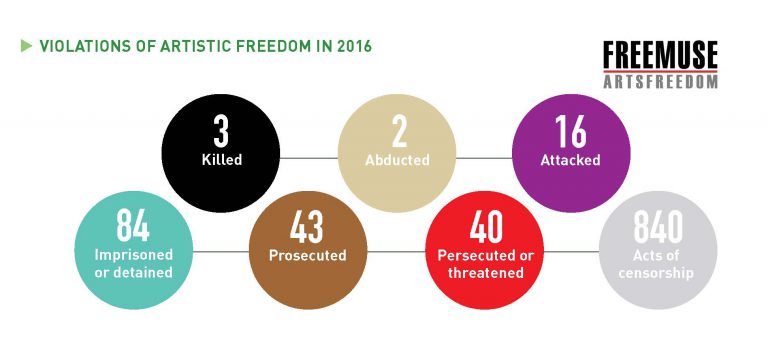The organization Freemuse, the world leader in advocating freedom of expression for musicians, has issued their annual report: ART UNDER THREAT IN 2016: PRESENTING THE FIGURES. Freemuse registered 1,028 attacks on artists and violations of artists' rights across 78 countries, revealing a trend of artistic freedom increasingly coming under threat.
The number of cases registered in 2016 more than doubled the amount registered in 2015, an increase of 119%, which translates to an extra 469 attacks.
Freemuse divides attacks on artistic freedom into “serious violations” – which include killings, abductions, attacks, imprisonments, prosecutions and persecutions/threats – and acts of censorship. Acts of censorship are also serious concerns, but separating them from the rest helps to distinguish the nuanced global picture of the artistic freedom. In essence, it highlights the difference between an attack, for example, involving a banned piece of art, from another attack in which an artist’s life or family were endangered.
Of the more than one thousand cases registered in 2016, Freemuse documented 188 serious violations of artistic freedom and 840 acts of censorship.
The increase in the number of cases can partially be explained by the fact that Freemuse, alongside its partners, has continued to improve its documentation methods and increasingly receives more information through its expanding and strengthening network. Additionally, the issue of artistic freedom, especially in a year of rising populism and nationalistic views in many countries, continues to gain attention. This has resulted in more individuals, groups and organisations reporting on incidents when artists are being silenced.
However, despite the increase in attention and the refinement of methodology, artistic freedom violations in many countries continue to be under-reported due to a variety of factors, including lack of public awareness, capacity and political will.
According to the report, 2016 saw incidents of violent militants and even peaceful civil society groups targeting artists and audiences with very different means, but with the same goal of stifling artistic expression. There were several cases of women, as well as LGBT artists, being discriminated, and even cases where artist syndicates and unions played the role of censor. The conflicts between Russia and Ukraine, and India and Pakistan, also showed that when two neighbouring countries fight over a contested region, cultural exchange can suffer greatly. Additionally, 2016 was a year with a number of cases of governments, specifically the governments of China and Turkey, attempting to censor and prosecute artists and art outside their own borders.
Get more detail on these incidents by reading the full report here.
You can help share the report with the social media hashtag #ArtUnderThreat


